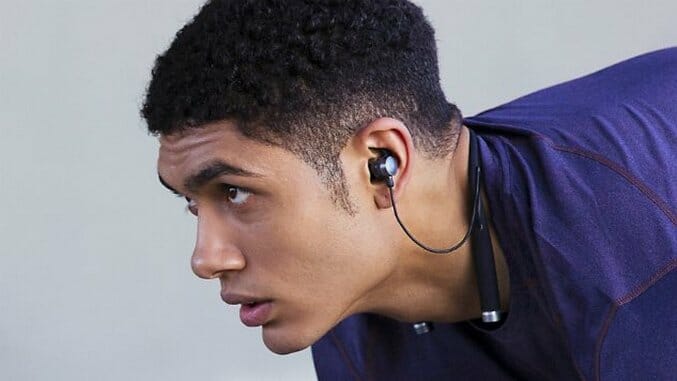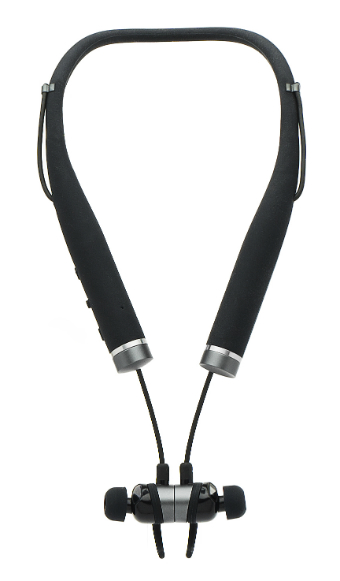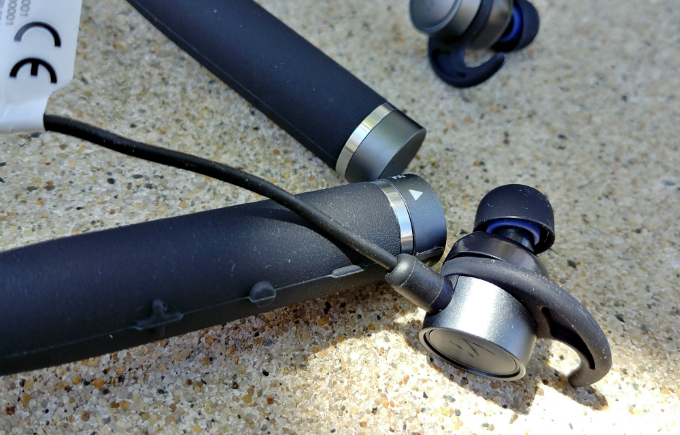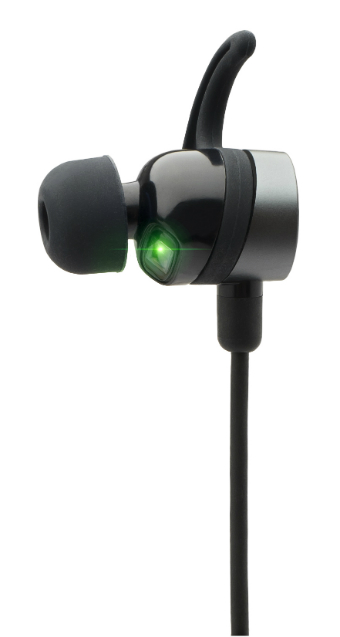
While most wireless headphones today attempt to connect you to your favorite music without the messy tangles of a corded experience, LifeBeam Labs’ Vi adds artificial intelligence to make its headphones smarter. For joggers looking to train, track vital stats to get peak performance or just get some extra motivation on a solo run, wearing Vi is like having a fitness coach in your ears.
Because LifeBeam is targeting fitness enthusiasts, Vi’s design is also more friendly to joggers. Unlike completely wireless Bluetooth earphones — like Apple’s AirPods and Bragi’s Dash and The Headphones — Vi comes with a flexible neckband with a rubbery coating, and the earbuds are attached to the collar. Vi just doesn’t need any wires to connect to your phones, but the earbuds are still wired to the flexible neckband.
The rubberized neckband hugs around the contour of my neck comfortably, but I wish it was a bit bigger so that it didn’t sit so tightly on my collar. And despite its light 1.3-ounce weight, Vi is weighted down enough that it doesn’t bounce around when I was jogging.
With wireless earbuds connected to a collar, Vi’s design is not unlike that of LG’s Infinim series or Samsung’s Level U Pro. Vi’s semi-tethered earphone design gave it a more reassuring feel, especially when you’re constantly moving around, compared to the completely untethered experience of wearing truly wireless earphones, like the AirPods. To keep the earbuds snug in your ears, Vi ships with gel tips in an assortment of sizes to achieve a proper fit — LifeBeam recommends you bring all the tips with you for your first run to see which feels best for you.
 When you’re not actively using Vi, the earbuds use magnets to snap onto the ends of the neckband. Vi comes with a very compact carrying case, and the flexible neckband folds around onto itself for storage.
When you’re not actively using Vi, the earbuds use magnets to snap onto the ends of the neckband. Vi comes with a very compact carrying case, and the flexible neckband folds around onto itself for storage.
As a hearable, Vi has a heart rate sensor embedded into the left earbud. If you’re the type of jogger who takes your music with you when you’re working out, the embedded heart rate sensor means you won’t need to wear another device — like a smartwatch — to keep track of vital stats. Vi rates the battery life for eight hours, so you’ll be able to get a few runs in or a full day of wear. I was able to wear Vi off and on through my work day, only turning them off when I have a meeting or conference call, without having to recharge.
Like other wearables, Vi works by connecting to the Vi Fitness app on your phone over Bluetooth — both iOS and Android are supported. The app can track your steps, distance, speed and heart rate by reading sensor data from the headphones. The app also uses your phone’s GPS location to give you weather information.
 By giving Vi a more human voice — compared to other apps that come with a more robotic voice coach — your interaction with Vi becomes more conversational. Equipped with a female voice, Vi immediately feels personal when you first power her on, and when you’re using Vi to coach you through a run, it feels like you’re jogging with an encouraging friend. When you set up the Vi Fitness app, you’ll be able to tell Vi your name and if, like me, you have a more obscure or harder name to say, she’ll ask you to pronounce it for her. You can even choose to be called by a nickname.
By giving Vi a more human voice — compared to other apps that come with a more robotic voice coach — your interaction with Vi becomes more conversational. Equipped with a female voice, Vi immediately feels personal when you first power her on, and when you’re using Vi to coach you through a run, it feels like you’re jogging with an encouraging friend. When you set up the Vi Fitness app, you’ll be able to tell Vi your name and if, like me, you have a more obscure or harder name to say, she’ll ask you to pronounce it for her. You can even choose to be called by a nickname.
Vi is capable of answering basic questions about your run — like what your pace and distance is, or how fast your heart is beating — along with weather information, so you can determine if it’s too warm still to start your run if you’ve been wearing Vi throughout the day. To call up Vi’s AI coach, just tap on the multifunction button on the right
Coaching is smart and adaptive, and Vi will give you useful advice based on the fitness goals you’ve established inside the app. LifeBeam cautions that you’ll need a good few hours with Vi, so she can truly get to know you and give you better coaching, but I found that Vi is smart enough to work straight out of the box. You’ll be able to tell Vi how present you’d want her to be during your runs — as a relative couch potato, I thought a more chatty Vi would be better suited for me.
 Even in those modes, Vi never felt overbearing. Unlike jogging with friends who are more seasoned runners, it never felt like I was struggling to keep up with Vi, nor was Vi slowing me down. In this sense, Vi is there to motivate you to achieve your realistic goals for running, and she isn’t a drill sergeant that will get you to best any Olympic records.
Even in those modes, Vi never felt overbearing. Unlike jogging with friends who are more seasoned runners, it never felt like I was struggling to keep up with Vi, nor was Vi slowing me down. In this sense, Vi is there to motivate you to achieve your realistic goals for running, and she isn’t a drill sergeant that will get you to best any Olympic records.
Vi’s friendly voice chimed in when she detected that I was slowing down, reminding me to boost my step count. She reminded me to take shorter strides, and she knew when I stopped at a red light to pause my workout.
Equipped with a microphone and Harmon Kardon-tuned audio experience, Vi offers decent sound — my music sounds fine when piped through the earbuds. Vi is able to play music off my phone, and it also integrates with Spotify. If you’re more into audio quality, there are definitely better quality earbuds out there, but Vi balances acceptable music performance with a natural-sounding AI coach. The microphone, on the other hand, struggles, especially on windy days or in louder urban environments. Under these conditions, Vi had a difficult time recognizing my voice or understanding me.
 While not being able to communicate with your coach, be it an AI one, can be frustrating initially, I have learned to surrender control and be more present in my workout. Most of my questions that I would ask Vi are related to time, distance and cadence, and I found that I can just let go and allow Vi to drive my workout and push me when it senses that I needed extra motivation.
While not being able to communicate with your coach, be it an AI one, can be frustrating initially, I have learned to surrender control and be more present in my workout. Most of my questions that I would ask Vi are related to time, distance and cadence, and I found that I can just let go and allow Vi to drive my workout and push me when it senses that I needed extra motivation.
I found that heart rate monitoring is pretty accurate, and readouts were on par with results that I obtained on my Samsung Gear S3, Garmin Fenix 3 HR and Fitbit wearables on my wrist. The only downside is that the left earbud — where the sensor is located — must be fitted perfectly for the heart rate sensor to work. Without a correct fit, the earbud may move around in your ear, and Vi wouldn’t be able to track this biometric data. In this instance, a wrist-worn accessory is more forgiving.
As a virtual coaching assistant, Vi has a lot of potential to grow, and it’s AI coach feels and sounds natural. However, at launch, Vi’s sweatproof design seems tailored around joggers and runners. I appreciated the smart coaching assistant, and the prompts that Vi gave really did help me achieve my fitness goals. That said, the coach will help you stay in shape or maintain your goals — it is not designed to get you to ready for the Olympic trials.
Given its size, LifeBeam could have added more components to the neckband to make Vi more of a standalone product than a wireless headphone that still requires tethering to a smartphone. Adding some storage to Vi, for instance, would allow you to store and play music independent of your phone. As it is, you’re still required to carry your phone when you’re using Vi for all of the features to work. In reality, given Vi’s AI smarts, you’ll find that you’ll be able to ditch your phone and rely on Vi to get you to your goals.
 If you can live with Vi’s bulkier size compared to Samsung’s Gear Icon X, Bragi’s Dash or Apple’s AirPods, the AI coaching assistant is well worth it. Experienced runners and serious athletes may not benefit from the coach, but her pleasant voice makes her an excellent running companion to keep beginners motivated and focused. If Vi can support more activities — like workouts at the gym, yoga or cycling — it will have even broader appeal.
If you can live with Vi’s bulkier size compared to Samsung’s Gear Icon X, Bragi’s Dash or Apple’s AirPods, the AI coaching assistant is well worth it. Experienced runners and serious athletes may not benefit from the coach, but her pleasant voice makes her an excellent running companion to keep beginners motivated and focused. If Vi can support more activities — like workouts at the gym, yoga or cycling — it will have even broader appeal.
As a germophobe, I don’t like going to spin classes because of all the sweaty people after a workout, but if Vi can coach me along, choose an amped up Spotify playlist for my session and keep me motivated, I’d feel more inclined to pedal harder when I’m on the bike at home or on a trail. The value in LifeBeam’s $249 asking price is that you’re getting a workout friend in Vi, who will keep you motivated to fulfill your New Year’s resolution. Hopefully, that fitness resolution is centered around running.